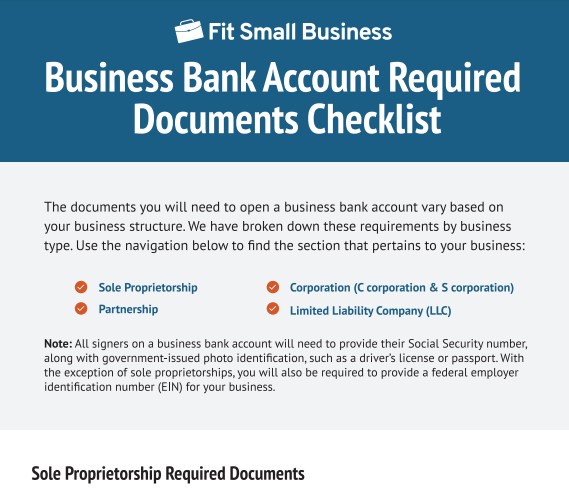We will walk you through how to open a business bank account—from gathering the required documents based on how your business is organized and choosing the right account, to counting the cost of fees and setting up online banking. Knowing ahead of time what kind of bank you want to build a relationship with and which account is the best fit for your business will make opening a business bank account easier.
You may also use our checklist when gathering the necessary documents to open the account. Every business is structured differently, so having a guide to make the process a little easier is helpful.
Step 1: Gather the Required Documents
Opening a business bank account has special requirements to be aware of before starting the process. The following lists may vary from bank to bank, but the required documents are listed below.
Documents Required Based on Organization Type
Businesses can be organized in a variety of different structures, and the documents vary depending on the way your business was formed. The requirements may be slightly different depending on the bank’s guidelines.
Step 2: Choose the Right Bank
Opening a business account can present challenges when trying to select from many of the leading banks for small businesses. The choices are vast, ranging from local in-person banks to online-only bank models, and the specifics of your business will help determine which type of bank structure is right for you.
Businesses that accept a large quantity of cash and checks may find banking at a local bank with a branch close by easier. Meanwhile, businesses that mainly receive payments electronically can pick between a local bank or an online-only banking model. Also, some banks offer promotional bonuses that may be of benefit, and you can find these in our roundup of the top business bank account promos and offers.
Tips on Choosing a Bank
Having an existing banking relationship can be helpful when opening a business account. Generally, the bank is already familiar with you and your business model, which makes banking a little easier. For more information, see our guide on why you shouldn’t change business banks.
Some business types are generally ineligible to open an account at a bank. These can include companies promoting gambling, medicinal products, or questionable behavior. You also may not qualify if you’ve had an account in the past that was force-closed due to negative balances, frequent overdrafts, or fraudulent activity. Banks share information regarding these kinds of closures through a system known as ChexSystems.
Most account holders today use some form of digital or online banking. Banking platforms can be accessed through their websites or mobile apps. Depending on your needs, online access will be beneficial in many ways, like helping you keep your business running smoothly while working on the go.
Having a bank that offers convenience will simplify things even further. Choosing a local bank will make in-person visits much more convenient especially if you need to make daily cash deposits. Partnering with the right bank is important to ensure you have all the financial tools needed to manage daily money flow.
When you first open your business, the less money spent on fees the better. Finding a bank with a clear fee schedule can be very helpful. This will allow you to plan ahead and avoid surprises when balancing our monthly statement.
Picking a bank that can grow with your business is key. You may have a small business now but it’s likely to grow over the next few years. When deciding on the perfect bank, try to look at its product offering with the future in mind to see if there is room for expansion.
Step 3: Select the Right Account
Now that you have the bank narrowed down, you will need to pick the right account from the options it offers. Reviewing your business model will help you choose the account that’s the best fit. Businesses that receive more electronic payments may choose a different account from a local business that is cash-heavy and needs money exchange services. Review the options with your needs in mind and you’ll likely see a clear path to the best choice.
Here are some account types with a suggested provider:
Type of Account | Description | Our Recommended Provider |
|---|---|---|
Free Business Bank Account | An account with no regular monthly fees; additional fees may apply if you add a service outside the standard account features | |
Traditional Business Checking Account | An account at a bank with a physical location offering in-person service options along with online capabilities | |
Online Business Checking Account | An account with a fintech company, which typically operates an online-only banking model without physical locations | |
Business Savings Account | An additional banking option allowing funds to be housed in higher interest-earning accounts structured to encourage saving | |
Business Money Market Account (MMA) | The best of both worlds, combining a checking and a savings account into one account type; allows for check writing and generally earns higher interest while encouraging saving |
For a more streamlined banking experience, it may be helpful to open multiple bank accounts for your small business at the same financial institution. This will make bookkeeping easier and allow for easier money movement through online banking.
Step 4: Count the Costs
It’s a good idea to look at the account costs before settling on one account over another. Some accounts may seem to be a good fit until you look at the cost involved in operating them.
The typical bank fees based on the account type are shown below:
Other fees banks may charge include:
- Cashier’s check fee
- Account research fee
- ATM card replacement
- Dormant bank account fee
- Account closure fee
- Rolled coin deposit
- Account research
- Check copy
- Check cashing fee
- Physical check order
- Safe deposit box fee
Step 5: Open the Account
Now that you’ve organized your legal documents and selected a bank and an account, it’s time to open the account.
- If you choose a local bank, it would be good to check the website to see if opening the account online is an option. If an in-person visit is required, you’ll need to coordinate with all your business partners so that everyone can be there together. This is very important since each signer would need to share their full legal name, physical address, and date of birth and submit their personal identification.
- If you’ve decided to go with an online-only bank, the account will be opened through its website. Be prepared to upload all your legal documents and complete the profile for all account owners. This process might be easier to do when everyone is together so that each person can provide the necessary personal information.
Step 6: Fund the Account
Funding the account is very important, and making your first deposit is one way to ensure the account is activated. I’ve seen many new accounts close or become dormant because they were never funded.
If you visit the branch, you can bring your deposit with you. For an online account, you may need to deposit the funds electronically. Once your account is activated, you will be given the option to make your first electronic deposit. Generally, each bank has automated steps that walk you through funding the account. Some common options are via mobile deposit, ACH, or wire.
Step 7: Set Up Online Banking
The lifeline to your finances is generally through online banking. You will be able to see at a glance all the transactions coming and going so you can keep track of your hard-earned dollars.
Getting online banking started may require some paperwork. Business online banking can be set up for multiple users needing access to the same information. If you have employees, you may need someone in your office to have access to assist with bookkeeping.
If permissions need to be assigned, generally the bank will provide you with a form to choose which functions each user will have access to. You can set limits on users to allow access to certain features while disabling others. If you have multiple accounts, you can also decide if you want all accounts visible on the logins or if they only need access to certain accounts.
Benefits of Opening a Business Bank Account
There are many benefits to opening a business bank account. Some of the most important ones include:
If you have an existing business checking account at another bank that you don’t plan on using anymore, you may want to close it when you open your new account so it doesn’t become a dormant account. Check out our guide on how to close a business checking account to guide you through the process.
Frequently Asked Questions (FAQs)
The required documents to open a business bank account will vary depending on the business’s structure, e.g., sole proprietor, partnership, corporation, or LLC. Each of these entity types will require legal company creation documents and a full list of these can be downloaded at the top of this article. Information about the signers on the account will also be needed, such as full legal name, address, phone number, and a government-issued ID.
Usually, there is no up-front cost to open a business bank account other than the initial deposit you will make to activate the account. If you decide to order checks at the account opening, there may be a small fee. The bulk of the fees will come as you start to use the account, and it’s best to review the fee schedule when opening a new business account so none of the fees you see on your monthly statement are a surprise.
There are quite a few factors that will help you determine which bank is the best fit for your small business. If you work in an industry that collects large amounts of cash and checks, you may consider opening an account at a local bank in your area to make banking more convenient.
If your primary form of payment is electronic, you can use a traditional bank or an online-only bank. Another factor to consider is the fee structure at each bank. Some banks have very low fees and include many features at no charge. Other banks may have charges for all features, which can lead to larger monthly fees.
Yes, an LLC needs its own bank account because the entity type provides a measure of personal protection. This protection may be removed when personal and business funds are commingled since it will appear the business and personal funds are one and the same. Separate accounts will also make bookkeeping and tax season easier.
Bottom Line
Now that you know how to open a business bank account, prepare the paperwork needed, including information about the business and the signers on the account, and opening the account will be fairly straightforward. In most cases, it will be ready to use the day you open it and you will be on your way to reaching your financial goals.

